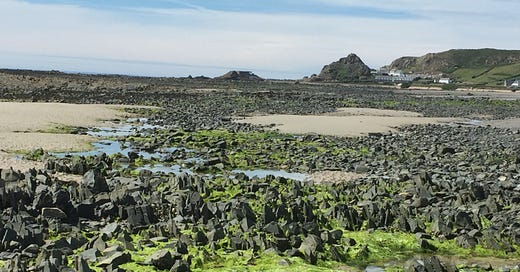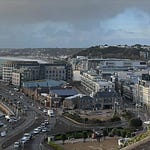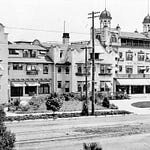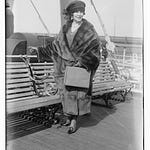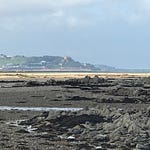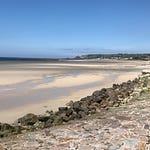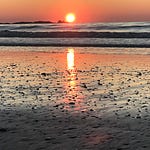Welcome to another episode of The History Islands. I hope you enjoy this week’s journey through Jersey’s rich and eventful history. As ever, if you enjoy the story, please share with family and friends ~ Paul Darroch
It’s such an easy mistake to make: to believe that Jersey’s splendid coastline, its stark granite cliffs and sandy beaches, must surely be as old as the hills. Yet our precious shores are barely a few thousand years old, carved out in the blink of a geological eye.
We are all perched here on a hill-top above the flood. All around us lies the original, drowned world; the hunting trails and barrows of our ancestors that have been swept away by the waves.
During the last Ice Age, the Jersey highlands towered over a vast plain of meandering glacial rivers and rich hunting grounds. When the ice retreated northwards and the meltwaters rose, Jersey became a peninsula, jutting out from the French coast. Some eight thousand years ago, the land bridge to France was finally severed. Jersey became a fully-fledged Island at last.
Folk memories of an older world somehow lingered on. Consider the curious legend of La Planche, telling of a sixth-century bishop of Coutances who still crossed a wooden bridge to greet his flock on the Ecréhous. Centuries later, we know that a chapel and priory were built there, with a great lantern to guide the sailors home. Some say the monks even tended fields there. Today we find just a few scattered huts, barely poking their snouts above the waves.
Another Jersey myth tells of the lost manor of La Brecquette, nestling amid rich orchards in St Ouen. Legend says that on one terrible night in 1356, it was swept away in a violent storm: simply erased from the map.
The turbulent sea would continue to shape Jersey’s destiny, ushering in waves of traders and invaders. The medieval age saw repeated attempts at conquest, and the Island languished under French occupation in the 1460s. The occupiers were eventually expelled; but the threat did not recede. In 1781, a French mercenary army marched straight into Royal Square, and was roundly defeated in the Battle of Jersey.
Yet the sea was also Jersey’s lifeline. It yielded rich fruit, as the impressive cod houses built with Newfoundland fishing money testify. Jersey learned to live by its wits, whether through the lucrative trade in woollen ‘jerseys’; or shipbuilding; or the exquisite oyster harvests of Grouville. The Island prospered.
Poised on the frontier of clashing kingdoms, Jersey welcomed more than its share of famous visitors. Governor Sir Walter Raleigh presided over the Island from 1600 to 1603. He graciously spared Gorey Castle from demolition and dedicated a new fortress to his beloved Queen, Elizabeth I. Less than fifty years later, Jersey provided a welcome refuge for the nineteen-year-old King Charles II, on the run from Cromwell’s forces. And few would ever forget the summer of 1846, when the young Queen Victoria stepped ashore to an ecstatic welcome. As tourism boomed in the long and peaceful era of the nineteenth century, even the ardent revolutionary Karl Marx found time to relax here on his seaside holidays.
The encircling sea, watched over from the impenetrable heights of Fort Regent, remained a comforting shield. But Jersey’s splendid isolation would finally end on a single day in the summer of 1912. It had been a rain-lashed and miserable summer; even Charlie Chaplin’s brilliant performance at the Opera House would not make up for the sodden potato harvest.
Yet an historic spectacle was about to unfold. It was August 26th, and the day of the St Malo-Jersey Hydro-Aeroplane races had dawned. The very first aeroplane was about to land in Jersey. As a flying-machine came into view over the horizon, the crowds turned delirious. When the aviator Jean Benoist landed his biplane on the sands near the bridge to Elizabeth Castle, he was mobbed by a swarm of onlookers.
Some local youths barged forward, oblivious to the potentially lethal rotors, and tried to carve their names into the biplane’s wings. The Centenier struggled to hold the line. Eventually Benoist refuelled, and with some difficulty, took to the air again. Alas, his early advantage in the race had been snatched by another competitor, who had landed at Beaumont on an empty stretch of beach.
As the planes vanished over the horizon, the strange hysteria passed, and the people of Jersey returned to their farms and their offices, back to their daily lives. Yet nothing would ever be quite the same again; the Island’s centuries-old solitude had finally been broken on that grey summer morning. The sea would no longer define Jersey’s destiny.
For better or for worse, the twentieth century had arrived.
(c) Paul Darroch 2021

